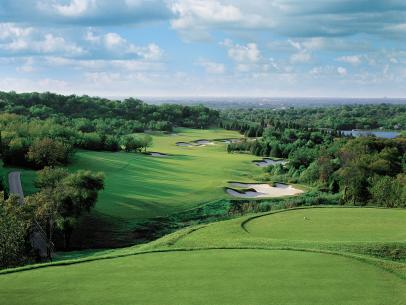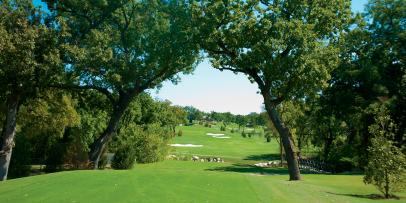Courses
Best golf courses near Dallas, TX
Below, you’ll find a list of courses near Dallas, TX. There are 54 courses within a 15-mile radius of Dallas, 31 of which are public courses and 23 are private courses. There are 46 18-hole courses and 6 nine-hole layouts.
The above has been curated through Golf Digest’s Places to Play course database, where we have collected star ratings and reviews from our 1,900 course-ranking panelists. Join our community by signing up for Golf Digest+ and rate the courses you’ve visited recently.

Time, and previous renovations, tend to shrink and constrict golf courses. The mission of this remodel by architect Keith Foster was to return Brook Hollow’s worn features to a better iteration of its first-generation A.W. Tillinghast design. Foster achieved magnificent results by accentuating the pedestal-like greens and bringing back their squared-off edges, installing steep-faced bunkers (as opposed to their previously flashed faces) and re-introducing several of Tillinghast's “great hazard” sand wastelands on holes like the par-5 15th.
View Course

It occupies some of the best golfing terrain in the Dallas Metroplex—rugged hills dotted with cedars—yet Tom Fazio still indulged in considerable shifting of earth when creating Dallas National. The par-3 17th, for instance, is countersunk into an excavated box canyon of rock, while a deep ravine in front of the 18th green was filled in to lessen the difficulty of the approach for average players. Major championship golf will return to the Dallas area in 2027 when the PGA Championship will be held at the newly-opened PGA Frisco site wiith course's built by Gil Hanse/Jim Wagner and Beau Welling, but Dallas National members feel they already have a course worthy of the task.
View Course

Once a drab, treeless, 165-acre tabletop city dump perched above the tree-lined Trinity River, Bill Coore and Ben Crenshaw transformed it into one of the most interesting designs in modern architercture. When Coore first saw the site, he ignored the abandoned refrigerators and scattered tires to focus on the flow of the land. It was a series of ridges and ripples formed as parts of the closed landfill settled over time. "It needed a good ironing," Coore joked. In the end his construction crew, though capping the site with a thick layer of sand in which to grow grass and create wasteland roughs, took pains to preserve every dip, trough, hump and hollow. It hosted the 2019 and 2020 AT&T Byron Nelson. Trinity Forest was night and day from any other venue on tour. As Curt Sampson wrote for Golf Digest, Trinity Forest "was night and day from any other venue on tour -- this windswept, nearly treeless expanse of dunes, waving prairie grass, and fast, undulating turf, the new place has every attribute of a links except cawing sea birds and an ocean." Not too many players embraced the cerebral, pinball-ish ground game offered to access some of these greens and navigate the interesting humps and bumps here. Of course, tour winner turned architect Geoff Ogilvy: “I love it,” Ogilvy said. “Strategically, it’s so interesting. It’s got everything that’s missing from modern architecture. There are ways to challenge golfers besides long rough and narrow fairways.” There are also architectural marvels like a double green, great short par 4s and short par 3s. It's too bad the tour won't return to Trinity Forest, but golfers lucky enough to get an invite will continue to enjoy it.
View Course

From Golf Digest Architecture Editor emeritus Ron Whitten:
Stevens Park Golf Course, a municipal operation in a revitalized area of Oak Cliff just southwest of downtown Dallas, isn’t exactly a preservation of the past, but a celebration of it. The original design was by a pair of club pros, Jack Burke, father of 1955 Masters champ Jack Burke Jr., and Syd Cooper, father of Lighthorse Harry Cooper, one of those “best players never to have won a major.”
The course was built on land donated by Walter A. Stevens and his sister Annie Laurie in memory of their parents, Dr. and Mrs. John H. Stevens.
In the early days, Stevens Park was a fun but funky affair, crisscrossed by so many hills, creeks, gullies, trees and city streets that one par 4 required a snap hook off the tee and three others demanded snap-slices.
In 2010, Metroplex course architect John Colligan and his then-associate Trey Kemp reconfigured the course, straightening holes and eliminating blind spots. They kept several original corridors, reversed the direction of seven holes and created eight fully new holes, increasing the length from 5,700 yards to about 6,300, a par 70. They also vastly improved turf conditions with modern irrigation and Bermuda grasses.
But they retained the fun factor at Stevens Park, mainly by emphasizing the geometric arrangement the old layout always had. Greens are still uniquely shaped, some rectangular, some diamonds, one perfectly round. Fairway mowing patterns zig and zag. There are six par 3s, some downhill, some uphill, and two of them back-to-back. It has four gambling par 5s, including the novel 16th that plays down a slope to an intersecting creek, then up and over a high cliff wall to a hilltop green. (The only hole even remotely resembling its configuration is the sixth at Pebble Beach.)
Most holes at Stevens Park are tight and tree-lined, many tees sit atop hills so drives are downhill and the par-4 15th offers an incredible, up-close view of downtown Big D. Best of all, green fees with a cart never exceed $60.
View Course

Located just south of downtown Dallas, Cedar Crest is an A.W. Tillinghast-designed public course that hosted the 1927 PGA Championship, won by Walter Hagen. The parkland course winds through trees and has relatively small greens, some of which have steep runoffs. In addition to the PGA Championship, the historic course also hosted the 1954 U.S. Amateur Public Links.
View Course

Tenison Glen, located just east of downtown Dallas, is one of two 18-hole layouts at Tenison Park. When it opened in 1924, it became Dallas’ first municipally owned golf course. White Rock Creek meanders through this tree-lined track, which hosted the 1968 U.S. Amateur Public Links.
View Course
Find more courses near Dallas, TX




